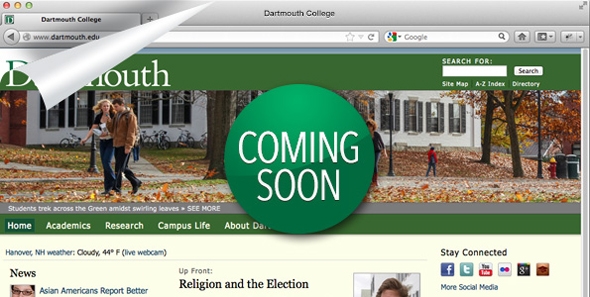The fate of political candidates isn’t the only thing about to change this month. In November, the Dartmouth home site—which includes the home page plus about 80 pages at the top level of www.dartmouth.edu—will launch in a new visual design. The improvements represent the first phase of a major upgrade of Dartmouth’s public web presence, which was last redesigned in 2006.

“The website is our front door to the world and the first point of contact most audiences have with Dartmouth,” says President Carol L. Folt. “This project is critical to serve and engage our diverse constituencies and effectively tell Dartmouth’s story. This bold, new communications platform also supports exciting initiatives throughout campus, such as the Year of the Arts and the Strategic Planning process.”
“I applaud our project team and partners across campus for their dedication to this effort,” she adds. “They have achieved rapid, positive change while looking ahead to develop strategies that meet Dartmouth’s long-term needs.”
Website Redesign TimelineThe redesign effort kicked off last May with a research and discovery effort that included extensive outreach to students, faculty, staff, parents, alumni, and other users of the site.Phase 1: Fall 2012
Launch of new visual design on the Dartmouth.edu home site (home page plus about 80 pages at the top level of the site)
Phase 2: Spring 2013
Launch of new home site, carrying forward Phase 1 design and adding new structure and content.
Launch of four Arts & Sciences academic department websites in new design: —Arts & Humanities: English—Interdisciplinary Programs: Institute for Writing and Rhetoric—Sciences: Biological Sciences—Social Sciences: Economics
New technology and utilities: —Content management system —Mobile-friendly, responsive design —Event calendar —Campus map
Phase 3: Begins spring 2013
Start migration of department, program, and center websites, with support from Web Services
Academic departments and websites serving external audiences are priorities in the migration process
Updates: Dartmouth HomeTeam blogQuestions: home.team@dartmouth.edu
Primary objectives include refocusing the top level of the website to better serve prospective students, faculty, and staff; providing a consistent, intuitive interface and clear paths for all users; and communicating Dartmouth’s global relevance and stature as a leading academic institution.
This fall’s visual update of the home site is just the start of this multi-phase project (see details at right), explains Sarah Memmi of the Office of Public Affairs, the project lead for communications.
“The phased strategy enables us to implement tangible improvements to the website on an aggressive timeline, even as additional components of the project continue to be developed,” says Memmi. “Another advantage is that we can involve user feedback as the redesign moves forward.”
By next spring term, a comprehensive overhaul of the home site will launch, carrying forward the new design and incorporating a new structure and content. Four Arts & Sciences academic department websites will also go live in the new design, and key utilities will be upgraded, including a new event calendar, campus map, and digital publishing platform (content management system).
Building on established practice and priorities, the redesigned website will be accessible to users with disabilities. A significant innovation coming in the spring will be a responsive design that functions seamlessly across multiple devices—desktops, laptops, tablets, and mobile phones.
“This is an ambitious effort that touches all of our audiences,” says Ellen Waite-Franzen, vice president for information technology, chief information officer, and the project lead for IT. “We’re encouraged by the significant amount of interest and thoughtful feedback from all areas of campus. We’re also grateful to President Folt and the senior leadership for providing the clear direction and support necessary for a successful result.”
The project’s third phase will focus on the migration of department, program, and center websites into the new design and publishing system. The entire Dartmouth.edu landscape includes thousands of microsites and more than 100,000 pages.
Dartmouth’s Web Services group will be facilitating the transition. Consistent with current practice, individual departments may choose to receive design and technology support from Web Services or resource their web needs independently.
“The feedback we’ve received about the redesign has been very positive,” says Susan Lee, director of Web Services. “We look forward to providing our clients with excellent service and robust design and technology solutions.”
Dartmouth has partnered with design firm Digital Pulp on the redesign. The New York-based firm was selected following a competitive bid and extensive review for its deep expertise, creative spark, and understanding of Dartmouth’s unique strengths and needs.
Updates on the redesign are being published to the Dartmouth HomeTeam blog. The project team also welcomes feedback and questions at home.team@dartmouth.edu.